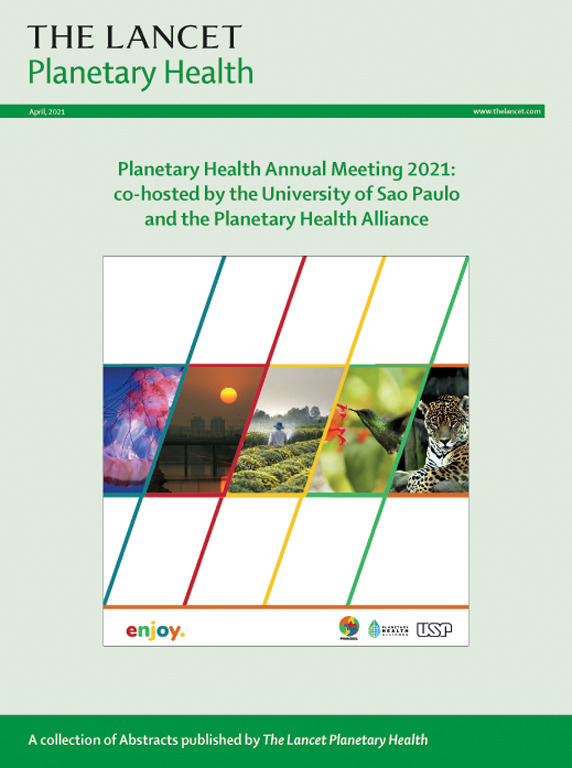A health impact assessment of progress towards urban nature targets in the 96 C40 cities
IF 21.6
1区 医学
Q1 ENVIRONMENTAL SCIENCES
引用次数: 0
Abstract
Background
Urban greenspaces (eg, parks and trees) and blue spaces (eg, rivers and coasts) improve climate regulation and human health. In 2021, the mayors of 31 cities in the C40 Climate Leadership Group set 2030 targets for the percentage of urban greenspace and population with nearby natural (green or blue) space. We quantified annual all-cause mortality reductions from progress towards these targets for C40's 96 member cities.
Methods
We conducted a quantitative health impact assessment, testing three illustrative scenarios to increase urban greenspace: uniformly across space, in areas with the least nature, and in the most populated areas. We converted one percentage point progress towards each target in terms of the Normalized Difference Vegetation Index (NDVI) using previously published associations. We used mortality rate estimates from The Global Burden of Diseases, Injuries, and Risk Factors Study, population data from WorldPop, and a pooled hazard ratio of NDVI and all-cause mortality from an epidemiological meta-analysis.
Findings
Uniformly increasing greenspace by 1% yielded an estimated 96-city median of 1·77 (range 0·65–3·52, IQR 1·46–2·19) fewer annual premature deaths per 100 000 population; increasing the population percentage with nearby natural space yielded an estimated median of 0·56 (range 0·11–1·70, IQR 0·44–0·69) fewer annual premature deaths per 100 000 population. On average, compared with uniform increases, adding greenspace in the least natural areas provided 1·4–1·7 times (depending on the target) the health benefits, and adding greenspace in the most populated areas provided 2·7 times the health benefits.
Interpretation
The geographical distribution of greenspace expansion influences the magnitude of associated health benefits across varied urban contexts. Health benefits are largest when greenspace is added near population centres.
Funding
Wellcome Trust, NASA, and The George Washington University.
对96个C40城市实现城市自然目标进展的健康影响评估
背景城市绿地(如公园和树木)和蓝色空间(如河流和海岸)可改善气候调节和人类健康。2021 年,C40 气候领导小组 31 个城市的市长为 2030 年城市绿地比例和附近拥有自然(绿色或蓝色)空间的人口设定了目标。我们对 C40 的 96 个成员城市在实现这些目标方面取得的进展所导致的年度全因死亡率下降进行了量化。我们进行了一项定量健康影响评估,测试了增加城市绿地的三种说明性方案:在整个空间内统一增加绿地、在自然条件最差的地区增加绿地以及在人口最稠密的地区增加绿地。我们利用以前发布的相关数据,以归一化差异植被指数(NDVI)来换算每个目标的一个百分点进展。我们使用了 "全球疾病、伤害和风险因素负担研究 "中的死亡率估算值、WorldPop 中的人口数据以及流行病学荟萃分析中 NDVI 和全因死亡率的综合危险比。研究结果如果将绿地面积均匀增加 1%,估计 96 个城市的中位数为每 10 万人每年减少 1-77 例过早死亡(范围为 0-65-3-52,IQR 为 1-46-2-19);如果增加附近有自然空间的人口比例,估计中位数为每 10 万人每年减少 0-56 例过早死亡(范围为 0-11-1-70,IQR 为 0-44-0-69)。平均而言,与均匀增加绿地相比,在自然条件最差的地区增加绿地可带来 1-4-1-7 倍(取决于目标)的健康益处,而在人口最稠密的地区增加绿地可带来 2-7 倍的健康益处。在人口中心附近增加绿地时,健康效益最大。
本文章由计算机程序翻译,如有差异,请以英文原文为准。
求助全文
约1分钟内获得全文
求助全文
来源期刊

Lancet Planetary Health
Multiple-
CiteScore
28.40
自引率
2.30%
发文量
272
审稿时长
8 weeks
期刊介绍:
The Lancet Planetary Health is a gold Open Access journal dedicated to investigating and addressing the multifaceted determinants of healthy human civilizations and their impact on natural systems. Positioned as a key player in sustainable development, the journal covers a broad, interdisciplinary scope, encompassing areas such as poverty, nutrition, gender equity, water and sanitation, energy, economic growth, industrialization, inequality, urbanization, human consumption and production, climate change, ocean health, land use, peace, and justice.
With a commitment to publishing high-quality research, comment, and correspondence, it aims to be the leading journal for sustainable development in the face of unprecedented dangers and threats.
 求助内容:
求助内容: 应助结果提醒方式:
应助结果提醒方式:


